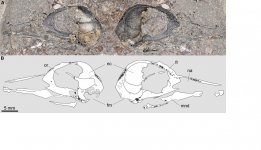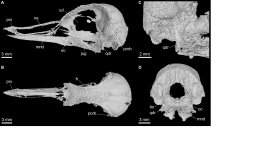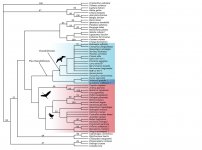Fred Ruhe
Well-known member

Miriam Heingård, Grace Musser, Stephen A. Hal & Julia A. Clarke, 2021
New Remains of Scandiavis mikkelseni Inform Avian Phylogenetic Relationships and Brain Evolution
Diversity. 13 (11): Article 651.
doi:10.3390/d13120651
Abstract and free pdf: New Remains of Scandiavis mikkelseni Inform Avian Phylogenetic Relationships and Brain Evolution
Although an increasing number of studies are combining skeletal and neural morphology data in a phylogenetic context, most studies do not include extinct taxa due to the rarity of preserved endocasts. The early Eocene avifauna of the Fur Formation of Denmark presents an excellent opportunity for further study of extinct osteological and endocranial morphology as fossils are often exceptionally preserved in three dimensions. Here, we use X-ray computed tomography to present additional material of the previously described taxon Scandiavis mikkelseni and reassess its phylogenetic placement using a previously published dataset. The new specimen provides novel insights into the osteological morphology and brain anatomy of Scandiavis. The virtual endocast exhibits a morphology comparable to that of modern avian species. Endocranial evaluation shows that it was remarkably similar to that of certain extant Charadriiformes, yet also possessed a novel combination of traits. This may mean that traits previously proposed to be the result of shifts in ecology later in the evolutionary history of Charadriiformes may instead show a more complex distribution in stem Charadriiformes and/or Gruiformes depending on the interrelationships of these important clades. Evaluation of skeletal and endocranial character state changes within a previously published phylogeny confirms both S. mikkelseni and a putative extinct charadriiform, Nahmavis grandei, as charadriiform. Results bolster the likelihood that both taxa are critical fossils for divergence dating and highlight a biogeographic pattern similar to that of Gruiformes
Enjoy,
Fred
New Remains of Scandiavis mikkelseni Inform Avian Phylogenetic Relationships and Brain Evolution
Diversity. 13 (11): Article 651.
doi:10.3390/d13120651
Abstract and free pdf: New Remains of Scandiavis mikkelseni Inform Avian Phylogenetic Relationships and Brain Evolution
Although an increasing number of studies are combining skeletal and neural morphology data in a phylogenetic context, most studies do not include extinct taxa due to the rarity of preserved endocasts. The early Eocene avifauna of the Fur Formation of Denmark presents an excellent opportunity for further study of extinct osteological and endocranial morphology as fossils are often exceptionally preserved in three dimensions. Here, we use X-ray computed tomography to present additional material of the previously described taxon Scandiavis mikkelseni and reassess its phylogenetic placement using a previously published dataset. The new specimen provides novel insights into the osteological morphology and brain anatomy of Scandiavis. The virtual endocast exhibits a morphology comparable to that of modern avian species. Endocranial evaluation shows that it was remarkably similar to that of certain extant Charadriiformes, yet also possessed a novel combination of traits. This may mean that traits previously proposed to be the result of shifts in ecology later in the evolutionary history of Charadriiformes may instead show a more complex distribution in stem Charadriiformes and/or Gruiformes depending on the interrelationships of these important clades. Evaluation of skeletal and endocranial character state changes within a previously published phylogeny confirms both S. mikkelseni and a putative extinct charadriiform, Nahmavis grandei, as charadriiform. Results bolster the likelihood that both taxa are critical fossils for divergence dating and highlight a biogeographic pattern similar to that of Gruiformes
Enjoy,
Fred






